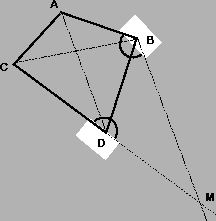



Next: Cross Ratios of Planes
Up: Cross Ratios of Pencils
Previous: Cross Ratios of Pencils
Any four distinct coplanar points (no three of which are collinear)
form a projective basis for the plane they span. Given four such
points A,B,C,D, a fifth point M in the plane can be characterized
as the intersection of one line of the pencil through D with
one line of the pencil through B (see
fig. 3.2). Hence, M can be parameterized by two
cross ratios (one for each pencil). This construction fails when Mlies on the line DB: in this case, another family of pencils has to
be considered. This is a common phenomenon in projective spaces: a
single system of coordinates does not cover the entire space without
singularities or omissions.
Figure 3.2:
Locating a fifth point in a plane
 |
Four-point bases can be used directly for visual reconstruction of
coplanar 3D points. Given four known points on a 3D plane and their
perspective images, a fifth unknown point on the plane can be
reconstructed from its image by expressing the image in terms of the
four known image points, and then using the same homogeneous planar
coordinates
 to re-create the corresponding 3D point.
to re-create the corresponding 3D point.




Next: Cross Ratios of Planes
Up: Cross Ratios of Pencils
Previous: Cross Ratios of Pencils
Bill Triggs
1998-11-13

![]() to re-create the corresponding 3D point.
to re-create the corresponding 3D point.